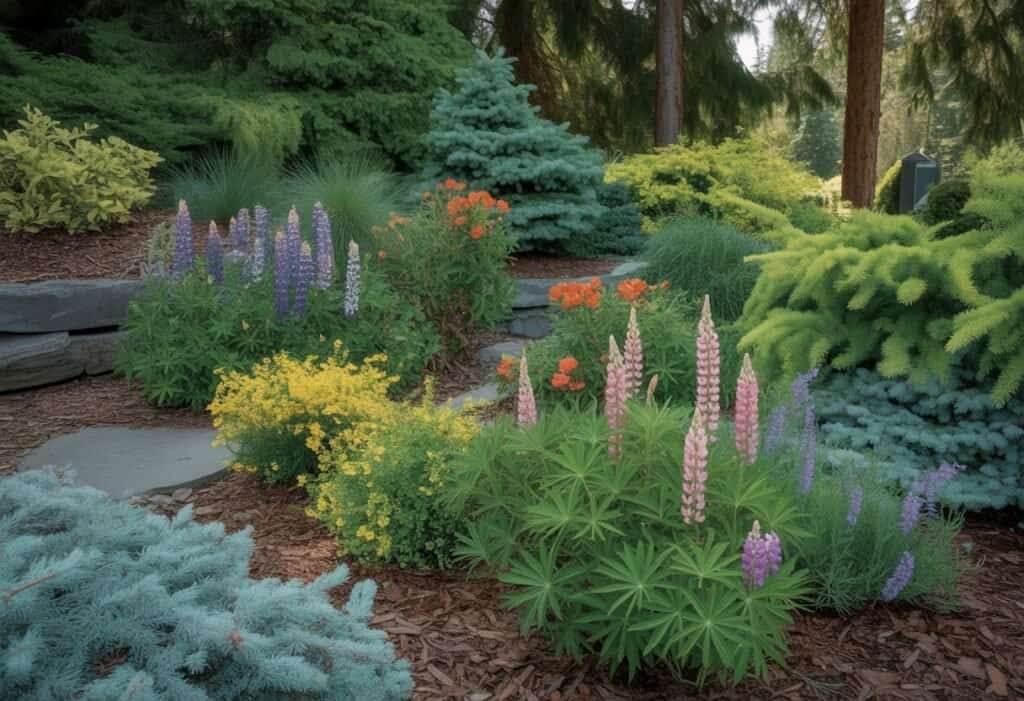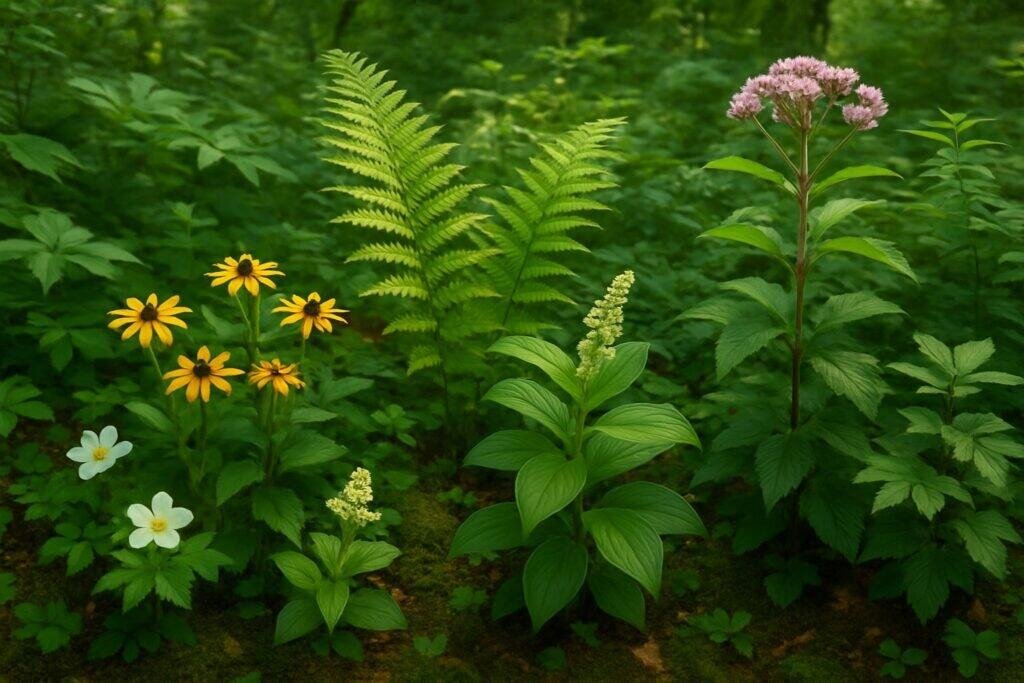Washington native plants offer a beautiful and sustainable approach to landscaping. Using plants that naturally grow in our state helps create gardens that thrive with minimal maintenance and support local wildlife.
Native plants have evolved to flourish in Washington’s specific climate and soil conditions. They resist drought and need fewer fertilizers, pesticides, and less watering than non-native alternatives.
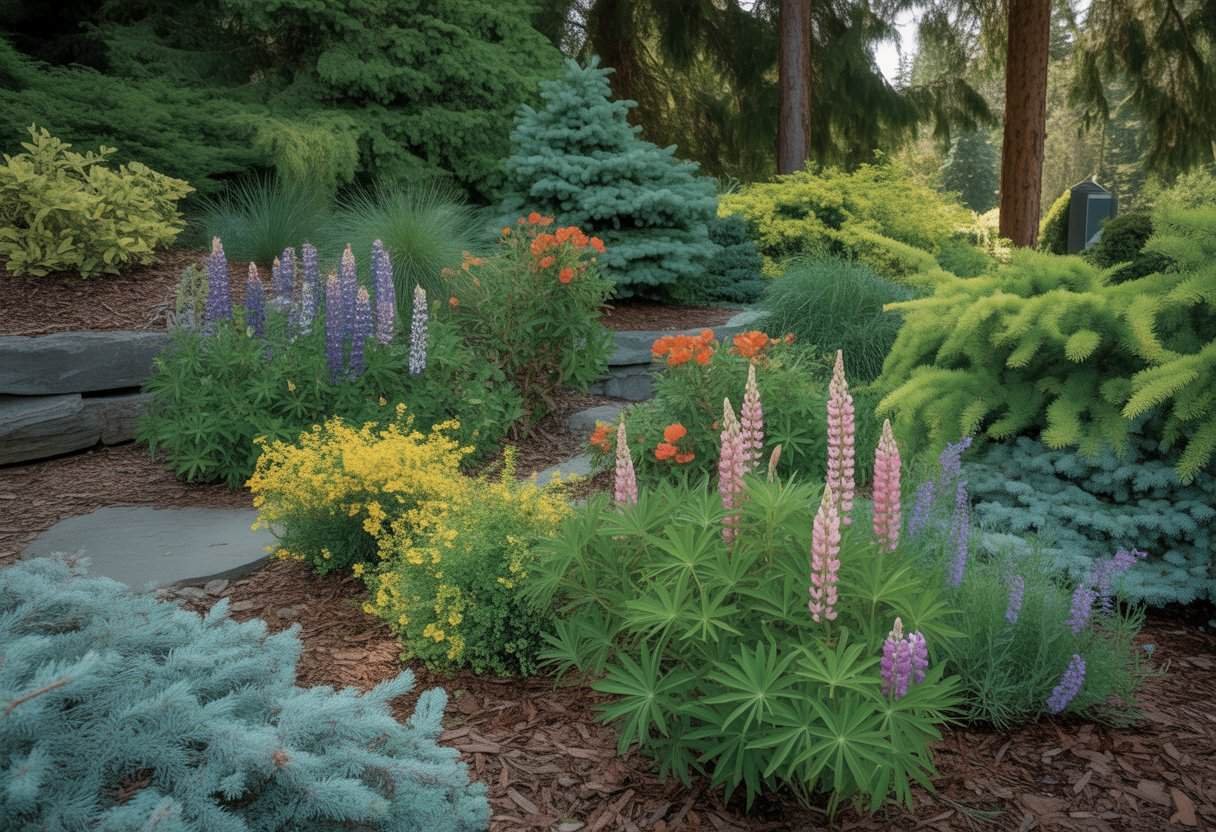
From the lush evergreen forests of western Washington to the drier landscapes east of the Cascades, our state offers a diverse range of native species. These plants provide food and habitat for native birds, butterflies, and pollinators while showcasing the beauty of the Pacific Northwest.
Key Takeaways
- Washington native plants need less water, fertilizer, and maintenance, creating resilient landscapes.
- Native plant landscaping supports local wildlife, including birds, butterflies, and pollinators.
- Incorporating native species preserves Washington’s botanical heritage and connects homeowners to the region’s natural beauty.
Benefits of Using Washington Native Plants in Landscaping
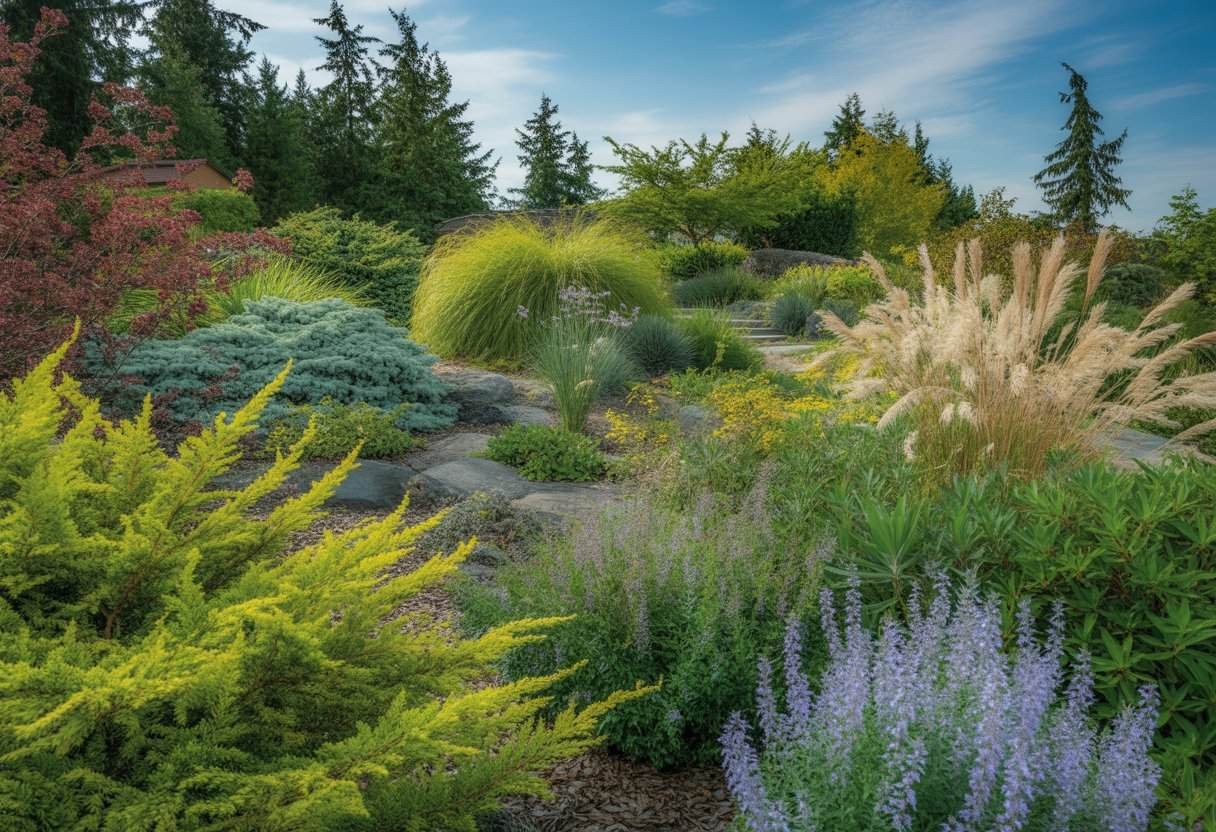
Native plants offer significant advantages for Washington landscapers and homeowners. These locally-adapted species create sustainable, beautiful gardens and support the unique ecology of the Pacific Northwest.
Supporting Local Ecosystems
Native plants form the foundation of Washington’s ecosystems. These plants evolved alongside local soils, climate, and wildlife, creating deep ecological connections.
The Washington Native Plant Society notes that indigenous plants help maintain regional biodiversity by preserving genetic diversity. When homeowners choose natives like salal, Oregon grape, or western red cedar, they help preserve these species in developed areas.
Native plant landscapes filter rainwater more effectively than conventional landscapes. Their root systems reduce erosion, especially on slopes and near waterways.
This natural filtration helps keep pollutants out of Puget Sound and other water bodies.
Enhancing Habitat for Birds and Pollinators
Native plants provide crucial food and shelter for local wildlife. Birds rely on native berries, seeds, and insects that native plants host.
A garden with Pacific dogwood, red-flowering currant, and snowberry attracts diverse bird species like chickadees, juncos, and hummingbirds. These plants provide berries, nectar, and nesting materials in different seasons.
Native plants also support essential pollinators. Bees, butterflies, and other insects depend on specific native flowers they co-evolved with.
For example:
- Douglas aster: Attracts many butterfly species
- Kinnikinnick: Provides early-season nectar for bumblebees
- Oceanspray: Supports over 20 species of native pollinators
Reducing Maintenance and Water Usage
Once established, native plants need much less maintenance than non-native alternatives. They adapt to Washington’s rain patterns and usually require little or no extra watering after their first year.
Native species like sword fern and salal thrive in Washington’s climate without fertilizers or pesticides. This reduces yard work and lowers the environmental impact of chemical treatments.
Natives like Idaho fescue and Oregon sunshine tolerate drought, making them perfect for water-wise landscaping. During dry summers, these plants conserve water while staying attractive.
Native plant gardens also reduce time spent weeding. Local plants establish strong roots that help prevent invasive species from taking hold.
Selecting the Right Native Plants for Your Garden
Choosing the right Washington native plants means understanding your specific garden conditions and using reliable resources. The right selections will thrive with little maintenance and support local wildlife.
Understanding Local Climate and Soil Conditions
Washington spans several climate zones from wet coastal areas to dry eastern regions. Before selecting plants, determine your specific hardiness zone (typically zones 6-9 in Washington).
Test your soil to understand its type and pH. Many Washington natives prefer well-draining soil, while others thrive in clay or sandy conditions.
A soil test kit from a garden center can help you find this information. Consider the sun exposure in your garden.
Map out which sections get full sun, partial shade, or full shade during the day. For example, Oregon grape thrives in shade, while lupines need full sun.
Water availability matters too. Western Washington gardens may support moisture-loving plants, while eastern Washington gardens might need drought-tolerant natives like sagebrush and bitterbrush.
Using Native Plant Guides and Lists
The Washington Native Plant Society offers comprehensive guides for different regions. Their website features searchable databases so gardeners can filter plants by growing conditions.
Local conservation districts often publish free native plant guides tailored to county-specific conditions. These guides include information about bloom times, mature sizes, and wildlife benefits.
Several books focus on Washington native plant gardening. “Landscaping with Native Plants of the Pacific Northwest” by Arthur Kruckeberg offers detailed information for western Washington gardeners.
Reliable Online Resources:
- King County Native Plant Guide
- Washington Department of Fish and Wildlife’s Backyard Wildlife Sanctuary Program
- WSU Extension Native Plant resources
Visit native plant nurseries for expert advice and to see mature specimens. Staff can recommend plants suited to your conditions.
Plant Identification Tips
Learn to recognize basic plant characteristics when identifying natives. Leaf arrangement, flower structure, and growth habit are key identifiers.
Take clear photos of unknown plants from multiple angles. Include images of leaves, flowers, and the overall plant.
Native plant apps like iNaturalist help with quick identification in the field. These tools use photo recognition to suggest possible plant species.
Field guides for the Pacific Northwest provide detailed identification information. Look for guides with color photos and simple keys.
Pay attention to scientific names when identifying plants. Scientific names ensure you’re selecting the correct species.
Popular Washington Native Shrubs and Trees
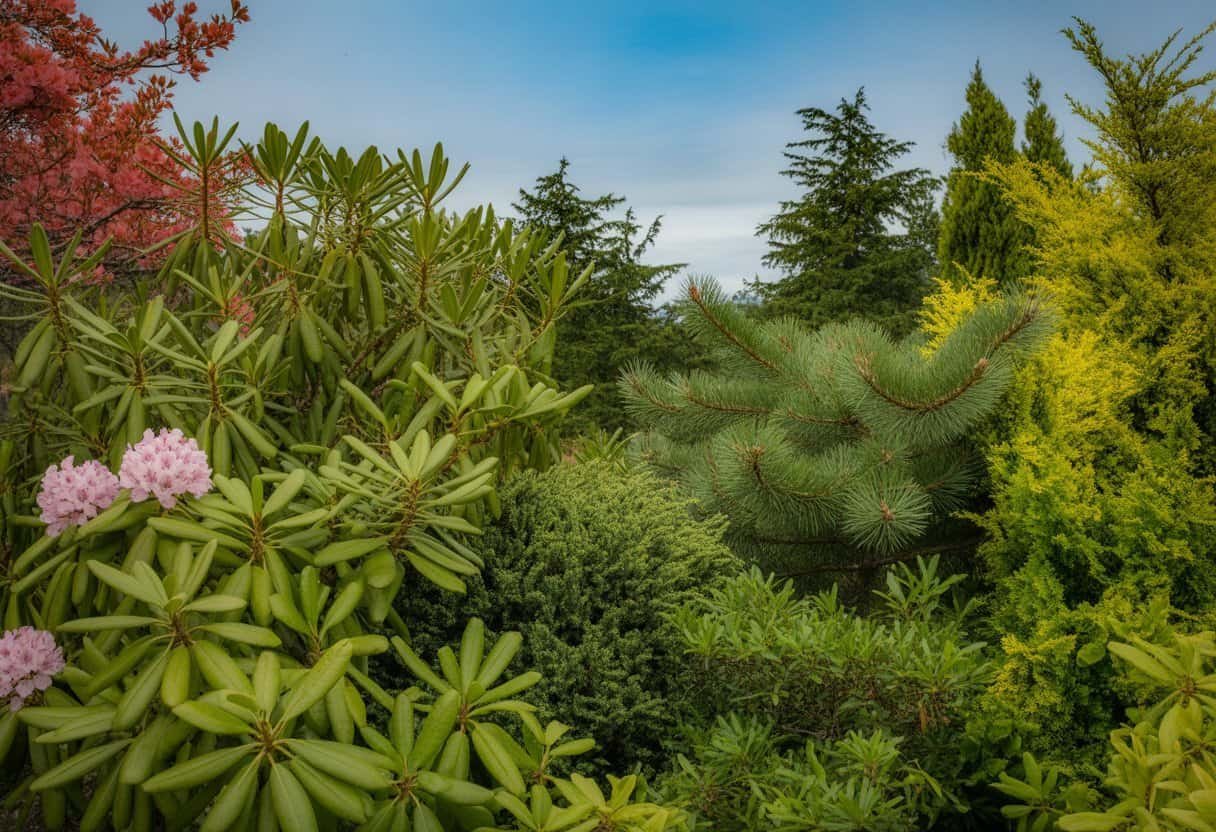
Washington’s landscape offers many beautiful native plants that thrive in local conditions. These shrubs and trees require less maintenance, support wildlife, and create authentic Pacific Northwest gardens.
Essential Native Shrubs for Landscaping
Red Elderberry (Sambucus racemosa) grows quickly in partly shady spots and produces white flowers in spring, followed by bright red berries. Birds love these berries, making this shrub excellent for wildlife gardens.
Oregon Grape (Mahonia aquifolium) offers year-round interest with shiny evergreen leaves, yellow flowers in early spring, and blue-purple berries. It grows 3-6 feet tall and works well as a natural barrier.
Salal (Gaultheria shallon) features glossy leaves and small pink-white flowers. This adaptable shrub thrives in shade or sun and grows 2-5 feet tall.
Red-flowering Currant (Ribes sanguineum) blooms with hanging clusters of pink flowers that attract hummingbirds in early spring. It reaches 6-10 feet and prefers sunny locations.
Snowberry (Symphoricarpos albus) produces distinctive white berries that persist through winter. This 3-4 foot shrub adapts to many soil types.
Preferred Native Trees for Home Gardens
Douglas-fir (Pseudotsuga menziesii) stands as Washington’s iconic evergreen. Though large in forests, you can manage it in spacious yards.
Its distinctive cones and year-round greenery make it a stately addition. Grand Fir (Abies grandis) offers fragrant needles and a symmetrical shape.
This evergreen grows more slowly than Douglas-fir, making it somewhat more suitable for home landscapes. Vine Maple (Acer circinatum) provides spectacular fall color and grows well in shade.
It typically reaches 15-20 feet and can be grown as a multi-stemmed small tree or large shrub. Pacific Dogwood (Cornus nuttallii) displays large white spring flowers and red berries in fall.
This understory tree prefers partial shade and reaches 15-30 feet tall. Western Red Cedar (Thuja plicata) features aromatic, scale-like foliage and reddish bark.
It’s perfect for privacy screens and can be pruned to control size.
Native Wildflowers and Perennials for Colorful Landscapes
Washington’s native wildflowers and perennials offer vibrant colors and support local ecosystems. These plants require less maintenance and provide food for wildlife.
Showy Wildflowers and Their Benefits
Common Camas (Camassia quamash) produces stunning blue-purple blooms in spring. This historically important plant was a food staple for indigenous peoples.
Red Columbine (Aquilegia formosa) displays distinctive red and yellow nodding flowers that attract hummingbirds. Its unique shape makes it a focal point in woodland gardens from spring through early summer.
Western Pasque Flower (Anemone occidentalis) offers early spring blooms with delicate white petals and fuzzy seed heads. This plant thrives in well-drained soils and partial shade.
Native wildflowers need minimal water once established. They have adapted to Washington’s climate over thousands of years, making them drought-resistant and low-maintenance.
Long-Blooming Perennials
Common Yarrow (Achillea millefolium) produces flat-topped white flower clusters that bloom from June through September. This versatile plant tolerates poor soil and drought conditions.
Blanketflower (Gaillardia aristata) offers red and yellow daisy-like blooms from early summer until frost. Its extended flowering period provides continuous color in landscapes.
Top Long-Blooming Native Perennials:
- Douglas Aster (Symphyotrichum subspicatum) – Purple flowers, August-October
- Broadleaf Lupine (Lupinus latifolius) – Blue-purple spikes, May-July
- Oregon Sunshine (Eriophyllum lanatum) – Bright yellow, May-August
These plants require little division or deadheading to perform well year after year.
Attracting Butterflies and Bees
Native wildflowers provide essential habitat for pollinators. Butterflies favor flat-topped flowers that serve as landing pads.
Milkweed (Asclepias speciosa) serves as the exclusive host plant for Monarch butterfly larvae. Its pink flower clusters also provide nectar for butterflies and bees.
Goldenrod (Solidago canadensis) blooms in late summer when other flowers have faded. It does not cause hay fever and provides critical late-season pollen for bees.
Plant these natives in groups rather than individually. Clusters of at least three plants of the same species create stronger visual impact and help pollinators find them.
Grasses and Groundcovers Native to Washington
Washington’s native grasses and groundcovers offer beautiful, low-maintenance alternatives to traditional lawns. These plants have evolved to thrive in our climate with minimal care and provide habitat for wildlife.
Top Native Grasses for Landscapes
Idaho Fescue (Festuca idahoensis) grows in blue-green clumps reaching 1-2 feet tall. This drought-tolerant grass keeps its color year-round and fits well in borders or meadow gardens.
Tufted Hairgrass (Deschampsia cespitosa) has airy seed heads that catch the light. It thrives in both sun and partial shade, making it suitable for many garden spots.
Blue Wild Rye (Elymus glaucus) features blue-green foliage and grows 2-5 feet tall. This grass handles drought once established and controls erosion on slopes.
California Oatgrass (Danthonia californica) forms neat bunches and stays green longer than many native grasses. It needs little mowing and can replace a traditional lawn.
Popular Native Grasses for Washington Gardens:
- Idaho Fescue (dry sites)
- Tufted Hairgrass (moist areas)
- Blue Wild Rye (versatile locations)
- California Oatgrass (lawn substitute)
Low-Maintenance Native Groundcovers
Kinnikinnick (Arctostaphylos uva-ursi) creates a dense evergreen mat with small white flowers and red berries. It thrives in poor soil and needs almost no maintenance once established.
Wild Strawberry (Fragaria virginiana) spreads by runners to form a natural carpet. Its white flowers and edible berries add interest and provide food for wildlife.
Inside-out Flower (Vancouveria hexandra) has delicate foliage and unique white flowers. It grows well in shady woodland gardens and covers ground with little care.
Coastal Strawberry (Fragaria chiloensis) features glossy evergreen leaves and edible berries. This tough plant tolerates salt spray, making it ideal for coastal gardens.
Best Native Groundcovers by Condition:
| Plant Name | Sun Exposure | Soil Type | Height |
|---|---|---|---|
| Kinnikinnick | Full to part sun | Well-drained | 6-12″ |
| Wild Strawberry | Sun to part shade | Average | 4-8″ |
| Inside-out Flower | Shade | Moist, rich | 12-18″ |
| Coastal Strawberry | Full sun | Sandy, well-drained | 4-6″ |
Designing and Maintaining a Native Plant Landscape
Creating a landscape with Washington native plants starts with careful planning and continues with ongoing care. These landscapes support local wildlife and need less maintenance than traditional gardens.
Planning Your Native Plant Garden
Begin by evaluating your site conditions. Check how much sun each area gets throughout the day.
Test your soil to learn about its composition and drainage. Match plants to your specific conditions for best results.
Douglas fir and western red cedar grow well in shady, moist areas. Kinnikinnick and Idaho fescue do best in sunny, drier spots.
Group plants with similar water needs together. This practice, called hydrozoning, saves water and keeps plants healthy.
Consider the mature size of plants when spacing them. Native plants often grow larger in gardens with good soil and water.
Create a planting plan with year-round interest. Use evergreens like salal for winter, red flowering currant for spring, camas for summer, and vine maple for fall color.
Creating Wildlife-Friendly Spaces
Layer your garden with trees, shrubs, and groundcovers to mimic natural habitats. This vertical diversity creates more spaces for wildlife.
Add plants that produce berries or seeds. Snowberry, Oregon grape, and serviceberry provide food for birds and small mammals year-round.
Wildlife Attracting Plants:
- Butterflies: Pearly everlasting, yarrow, goldenrod
- Hummingbirds: Red flowering currant, columbine, trumpet honeysuckle
- Bees: Oceanspray, Douglas aster, camas
Leave some areas with fallen leaves and branches. These materials shelter beneficial insects and enrich soil as they break down.
Add a small water feature if you can. Even a shallow bird bath attracts and supports wildlife in your garden.
Ongoing Care and Seasonal Maintenance
Water deeply but not often during the first 2-3 years. Once established, most native plants need little extra water except during severe drought.
Avoid chemical fertilizers and pesticides. They can harm the soil organisms that native plants need.
Mulch with leaves, pine needles, or bark to keep weeds down and hold moisture. Use a 2-3 inch layer, but keep mulch away from plant stems.
Prune only when needed. Most native shrubs look best in their natural form, so remove only dead or damaged branches.
Watch for invasive species and remove them quickly. Himalayan blackberry, English ivy, and herb Robert are common invaders.
Divide spreading native perennials like Douglas aster every 3-4 years to keep them healthy and control their spread.
Resources and Community: Where to Learn More
Reliable information and quality native plants help ensure success in Washington landscapes. Local organizations, educational resources, and specialized nurseries offer guidance for gardeners at all levels.
Washington Native Plant Society Programs
The Washington Native Plant Society (WNPS) is a key resource for native plant enthusiasts. They hold monthly meetings with expert speakers on plant identification and restoration techniques.
WNPS leads regular field trips with botanists who help participants identify native plants in the wild. These trips take place throughout the year in different Washington ecosystems.
Their stewardship program offers hands-on experience with native plant restoration. Volunteers learn practical skills and help with conservation work.
The society holds plant sales in spring and fall, offering hard-to-find native species grown by members. These events let you talk with experienced growers about plant care.
Educational Materials and Workshops
Several field guides focus on Washington native plants. Plants of the Pacific Northwest Coast by Pojar and MacKinnon and Gardening with Native Plants of the Pacific Northwest by Kruckeberg are excellent references.
Washington State University Extension offers online courses and in-person workshops on native plant landscaping. Their Master Gardener program trains volunteers who share native plant knowledge with the community.
Free online resources include the Burke Museum’s “WTU Image Collection” with thousands of plant photos and the “Washington Native Plant Guide” website with searchable plant databases.
Local community colleges often have classes on native plant identification and landscape design. These courses usually include fieldwork and practical design exercises.
Recommended Plant Nurseries and Online Resources
Specialty Native Plant Nurseries in Washington:
- Fourth Corner Nursery (Bellingham)
- Sound Native Plants (Olympia)
- Storm Lake Growers (Monroe)
- Native Foods Nursery (Morton)
- Forest Concepts (Auburn)
These nurseries focus on Washington natives and offer plants adapted to specific local conditions. Many provide consultation services to help homeowners choose the right plants.
Online marketplaces like the King Conservation District’s Native Plant Sale offer seasonal sales with pre-orders.
The Native Plant Network (www.nativeplantnetwork.org) provides propagation protocols for many species. This resource helps gardeners learn how to grow challenging plants from seed.
Frequently Asked Questions
Washington gardeners often ask about using native plants in their landscapes. These plants offer beauty, environmental benefits, and need less maintenance when chosen for the right conditions.
What are the best native plants to use for landscaping in the Pacific Northwest?
Several Washington native plants perform well in landscapes. Douglas spirea has pink summer flowers, thrives in moist soils, and attracts butterflies.
Red-flowering currant produces bright pink-red blooms in early spring and provides nectar for hummingbirds. It adapts to many soil types.
Sword fern adds texture year-round with its evergreen fronds. It grows well in shady gardens with little care.
Western serviceberry features white spring flowers, edible berries, and colorful fall leaves. It works as a specimen tree or in mixed shrub borders.
Where can I find native plant nurseries in Washington state?
The Washington Native Plant Society lists specialized nurseries across the state on their website. These businesses focus on locally-adapted species.
Many county conservation districts hold annual native plant sales in late winter or early spring. These events offer affordable bare-root plants and expert advice.
Some conventional nurseries now have native plant sections. The Arbor Day Foundation and National Wildlife Federation also offer native species online.
Which native plants are suitable for a low-maintenance garden in Western Washington?
Kinnikinnick makes a great evergreen groundcover in sunny, poor soil. Once established, it rarely needs water or care.
Oregon grape varieties add year-round interest and need little maintenance. Their yellow flowers and blue berries attract wildlife.
Salal grows in shade to part-sun with acidic soil. This evergreen shrub helps control erosion on slopes.
Pacific ninebark handles poor soil and needs little water once established. Its peeling bark adds winter interest.
How do native plants benefit local ecosystems in Washington?
Native plants give local wildlife the habitat they need. They evolved with native birds, insects, and mammals, offering food and shelter.
These plants help keep watersheds healthy. Their deep roots prevent erosion, filter pollutants, and improve soil.
Native species use fewer resources than non-natives. They need less water, fertilizer, and pest control after they are established.
Using natives helps protect Washington’s plant heritage. Many native plant communities face threats from development and invasive species.
Can you recommend any native flowering plants that thrive in Eastern Washington’s climate?
Blanketflower handles Eastern Washington’s hot, dry summers. Its yellow and red flowers bloom from early summer through fall and attract pollinators.
Idaho fescue forms attractive blue-green clumps. This drought-tolerant grass works in naturalistic plantings and needs little irrigation.
Arrowleaf balsamroot produces bold yellow blooms in spring. It grows deep roots to survive harsh conditions without extra water.
Penstemon species, such as hot rock penstemon and Payette penstemon, thrive in dry, sunny spots. Their tubular flowers attract hummingbirds and native bees.
What native grass species are ideal for creating sustainable lawns in Washington?
Red fescue forms a soft, fine-textured lawn alternative. It requires minimal mowing and thrives in both sun and partial shade throughout the state.
Idaho bentgrass creates a dense turf suitable for moderate foot traffic. It looks better during summer drought than conventional lawn grasses.
Blue wildrye establishes quickly and tolerates varied conditions. This grass works best in meadow-style plantings and provides excellent erosion control.
Tufted hairgrass grows well in moist areas, including rain gardens and bioswales. Its attractive seed heads add movement and texture to landscapes.

